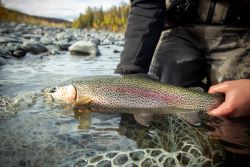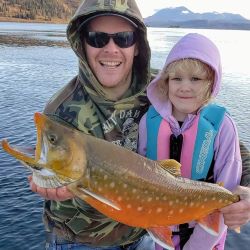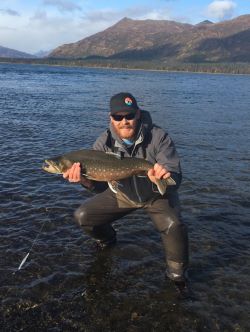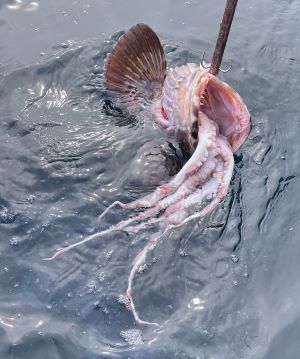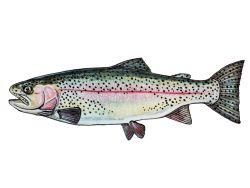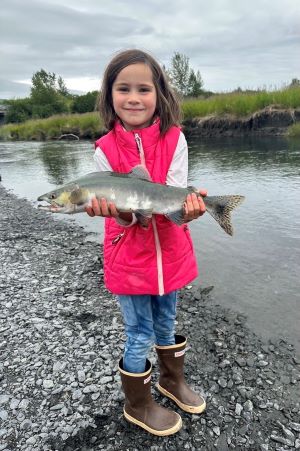
September 2024
Issue 81
A Fishy Fall Season
This fall season offers a great time to take advantage of some exceptional fishing opportunities. There are countless areas across the state to pursue resident species such as rainbow trout, Dolly Varden, northern pike, lake trout, and coho (silver) salmon. And there's still plenty of opportunity to get out on the salt water in pursuit of species such as halibut and lingcod.
We hope the content in this edition of Reel Times will help inspire you to get out and fish.
Before you head out, be sure you have your 2024 sport fishing license. Visit our online store if you need to purchase one. Or download the ADF&G mobile app and you can store your licenses, tags and permits in your mobile device.
If you have a comment or story ideas for Reel Times, we encourage you to send them our way. You can send comments to ryan.ragan@alaska.gov.
We'll see you on the water.
Fall Fishing for Bristol Bay Arctic Char
By Lee Borden, Area Management Biologist - Bristol Bay
Fall time in Bristol Bay is a season that brings with it many fishing opportunities that are well known to anglers who frequent the waters of Southwest Alaska. There are popular fisheries around the Bay during this time, from hot bites for coho salmon in the early portion of the fall to a world-renowned fall rainbow trout season that lasts well into October. These two fisheries in particular garner a lot of attention, and rightly so! However, if you're an angler looking for something a bit different that often flies under the radar but can produce big and beautiful fish, then you may want to investigate targeting Arctic char. The lakes of Bristol Bay contain some of the best Arctic char angling opportunities in the state.
When the air begins to get crisp and cool in the mornings and the leaves begin to fall from the trees the Arctic char start to congregate near the mouths of streams that empty into the lakes in Bristol Bay. They are there for two reasons, one leading into the other over time. At the onset of fall, Arctic char begin to congregate at the mouths of streams that empty into lakes for the purpose of feeding on salmon eggs and flesh that get washed out of the streams. Often there will be drop-offs that are associated with the flow of water from these tributary streams into the lakes and Arctic char will sit on the drop offs waiting for eggs or tasty morsels of flesh from decaying salmon to tumble down the incline and directly into their waiting mouths. As the season progresses these feeding congregations transition into spawning congregations. Arctic char use these locations as staging points before moving to spawning areas in other parts of the lake. If you are fortunate enough to time it right, you can have a fantastic day of fishing with aggressive hits and large colorful fish.
As the season progresses into late fall Arctic char begin to transition into their spawning colors. Firey orange bellies become more and more colorful as the season progresses. Arctic char can become quite bright before they leave the river mouths and progress to spawning areas along the shorelines just prior to ice beginning to form along the edges of the lakes. The later you wait the more colorful the fish will become, but don't wait too long or you may arrive at the river mouths after the fish have departed to move into more dispersed schools in scattered spawning locations that differ from lake to lake.
Targeting the abundant Arctic char when they are congregating is a blast and if you hit it right you may encounter a situation where you are catching as many fish as your heart desires. Using a vast array of terminal tackle can be productive including but not limited to spinners, spoons, jigs, flesh flies, streamers, and nearly anything else that flashes and catches their eye. Arctic char can be quite aggressive at this time, and it is generally more a matter of getting your gear into the aggregation of fish than it is about what type of gear you are using. Fish can be caught on nearly anything that is presented to them at this time. Arctic char are in a hyper aggressive feeding mode during the fall as they fatten up to prepare themselves to spawn and then endure a long cold winter under the ice.
Timing the Arctic char fall aggregations can sometimes be a bit tricky, and each season is a little bit different. Salmon run timing dictates the start timing of Arctic char feeding aggregations and can be variable year to year. Salmon spawning activity followed by their inevitable die off and decay can take place a few weeks earlier or later in any given year depending on various factors that include water temperature, water level, timing of the salmon migration and abundance of fish present on the spawning grounds. The feeding aggregations transition into spawning aggregations that stage at the river inlets on the lakes and can last well into November. Once Arctic char are ready to spawn, the aggregations will disperse from the river mouths so timing your trip as late as possible to optimize the brightest color without missing the aggregations can be tricky but is well worth the gamble when you time it correctly.
Bristol Bay can provide you a unique angling opportunity that is often overlooked but rarely disappoints. So grab your best cold weather attire for the brisk fall weather in Bristol Bay, gather up your fishing companions and be sure to bring a warm beverage to keep you going in the near freezing conditions and come give Arctic char a go in Southwestern Alaska.
Lingcod Dynamite
By Craig Schwanke: Prince of Wales Area Management Biologist, and avid saltwater angler
By coincidence, the day I wrote this article I overheard a conversation occurring at the front counter at the Alaska Department of Fish and Game office in Craig. An angler described reeling in a rockfish when suddenly, his fishing rod loaded up with a lot of extra weight. He continued reeling his line and a "huge" lingcod appeared below the boat with a hooked rockfish in its toothy mouth. This isn't just your typical exaggerated big fish story anglers are famous for, but a common story by anglers fishing the coastal waters of Southcentral and Southeast Alaska.
Lingcod are famously voracious fish with a distribution in Alaska from Southeast Alaska to the Aleutian Peninsula. Lingcod have a diverse diet of basically any fish they can fit in their mouth including rockfish and salmon, as well as octopus, squid and crab. They seem fond of octopus as I've seen several with octopus tentacles extending out of their mouth from their stomach (see photo).
A friend and I were fishing on the outer coast of Prince of Wales (POW) this summer and as we trolled by numerous seabirds such as auklets, murres and murrelets, we wondered if lingcod ever consume these deep diving birds. A quick internet search did not answer our question, but I suspect a deep diving bird does periodically end up in lingcod diets.
Lingcod are a desired game fish due to their aggressive nature, large size, unique appearance and table fare. They are a fun fish to target with jigging gear as they hit hard, shake their heads upon being hooked and immediately dive towards the bottom with a strong run. They are also commonly caught mooching with herring, using bait on the bottom for halibut, and seem to be very attracted to flashers used for salmon trolling. I have flashers with tooth marks in them that I'm pretty sure are not caused by king salmon.
When jigging, a variety of lures work such as large twister tails, as well as lead and metal fish imitating jigs. Pounding the jigs on the bottom seems to attract lingcod but it is also a good idea to reel presentations up off the bottom 20 feet or so to get a lingcod to chase it up from the bottom for an aggressive strike. I recently hosted some fishing buddies that were interested in catching some nice lingcod. After a slow stretch of fishing with my typical assortment of lingcod lures, I told them I was breaking out the lingcod "dynamite," more commonly known as a pipe jig. Our fishing success immediately picked up with numerous nice lingcod, rockfish and halibut. Admittedly, I initially was very skeptical of pipe jigs when a friend encouraged me to give them a try. Basically, it is a 6-10" piece of copper plumbing pipe rigged with a hook and filled with lead. I don't know why but pounding this heavy piece of copper and lead on the bottom is deadly on lingcod. We were all disappointed when we lost my last pipe jig trying to release a large lingcod at the boat.
The Alaska Department of Fish and Game does not conduct lingcod population assessments, but based on staff observations, catch and harvest data and angling reports lingcod populations appear healthy within their Alaska range. Due to their susceptibility to anglers, lingcod are managed conservatively in Alaska with varying seasonal closures depending on regional location during the winter and spring when they spawn. In addition, the Southeast Alaska lingcod harvest is allocated between commercial and sport fishermen and the sport harvest has increased in recent years. The sport fishery has a guideline harvest level (GHL) which varies by management area. The department is mandated to keep harvest below the GHL and this is achieved by having more restrictive lingcod bag limits for nonresident anglers which comprise the majority of anglers in the charter fleet. While resident anglers throughout Southeast Alaska are allowed to keep one lingcod per day without a size limit, nonresident anglers are allowed two lingcod per season; one within a length slot limit that has ranged from 30 to 45 inches down to 30 to 35 inches, and one over 55 inches. Lingcod over 55 inches are very rare, so seldom harvested. The nonresident length slot limit varies by management area and some management areas had a nonresident closure from June 15 through July 31 in 2024. The Southeast Alaska lingcod regulations are set preseason by Emergency Order but are included in the Southeast Alaska fishing regulations, so be sure to check the regulations for the area fished.
My introductory angler's story ended with the lingcod letting go of the rockfish before the angler could net it, but it is not uncommon for a lingcod to stubbornly hold onto the rockfish until netted. Many anglers don't realize that lingcod that grab a rockfish and are brought to the boat must be released since rockfish are not legal to use for bait. Fortunately, lingcod are willing biters and anglers can often catch another lingcod for the cooler using legal angling methods.
Interior lakes get fresh batch of fish for fall fishing
By Tim Mowry, Information Officer, Fairbanks
Just in time for fall fishing in the Interior, staff at the Ruth Burnett Sport Fish Hatchery in Fairbanks stocked several lakes in Fairbanks and Glennallen with a fresh batch of rainbow trout.
And we're not talking about the standard 9- to 10-inch, pan-sized rainbows that are typically dumped in lakes. These fish were fatties, averaging just over 12 inches in length and 12 ounces in weight.
"These rainbows are noticeably larger compared to the fish we stocked earlier in the spring and summer," Tanana Area Management Biologist Andy Gryska said. "If you catch a few of these rod benders you'll have enough for a family feast."
Hatchery staff stocked almost 13,000 of those robust rainbows into five lakes on August 21-22. Chena Lake in North Pole was stocked with 6,293 rainbows, Cushman Lake in south Fairbanks received 2,026 rainbows, Ballaine Lake in west Fairbanks was stocked with 1,072 rainbows, Mile 47.9 Pond on Chena Hot Springs Road got 825 rainbows and Olnes Pond off the Elliott Highway north of Fairbanks was stocked with 652 rainbows.
Hatchery staff stocked another 25,578 rainbow trout into nine different lakes in the Glennallen and Fairbanks areas between August 23 and September 3. In the Glennallen area, Pippin Lake was stocked with 2,843 catchable-sized rainbows, Tex Smith Lake received 552 rainbows, Two Mile Lake near Chitina got a fresh batch of 1,006 rainbows and Old Road Lake and Round Lake on Lake Louise Road were stocked with 321 and 430 fish, respectively.
In the Fairbanks area, Chena Lake was stocked with another 2,218 catchable-sized rainbows. Three other lakes were stocked with rainbow fingerlings in the 3-inch range. Those lakes included Little Harding Lake (5,000 fish), Birch Lake (9,694 fish) and Lost Lake (3,514 fish).
"Anglers are encouraged to get out and harvest these fish before winter hits and lakes freeze over," Gryska said. "The fish bite great during the fall and early winter, but it's easier when you don't have to drill a hole through the ice.
"We'll be doing another fall stocking with landlocked king salmon in late September and early October for the ice fishing season," he said.
Try fishing salmon eggs or pieces of shrimp 8-12 inches below a bobber or you can try fishing a fly about six to eight inches below a casting bobber for those times when the fish are feeding on insects, but you don't have a fly rod. Small spinners will also attract the attention of rainbow trout.
Last week, hatchery staff also stocked almost 13,000 subcatchable lake trout and Arctic char into five different lakes in Fairbanks and Delta. The lake trout subcatchables averaged 4.5 inches in length while the Arctic char subcatchables were about 3.5 inches in length. Birch Lake was stocked with 3,000 lake trout and 3,400 Arctic char; North Twin Lake received 201 lake trout; Lost Lake was stocked with 451 lake trout and Rapids Lake was stocked with 201 lake trout. Harding Lake was stocked with 5,613 Arctic char. It will be another year or two before those subcatchables are big enough to harvest.
For a complete list of stocked lakes in the Interior and statewide, check out the Alaska Lake Database to see when lakes were stocked, how many fish were stocked and what kind of fish were stocked. You can also consult the Tanana River Drainage Stocked Lakes Fishing Guide to find locations and directions to all stocked lakes in the Interior.
Many stocked lakes also have great camp sites or you can reserve a free ADF&G public-use cabin at one of five stocked lakes in the Delta Junction area.
Hatchery staff will start stocking lake trout in select lakes this week. Later this month, hatchery staff will be stocking landlocked king and silver salmon into several lakes for the winter ice fishing season.
Send Us Your Best Shot!
The Alaska Department of Fish and Game (ADF&G), Division of Sport Fish is now accepting photo submissions for the 2025 Sport Fishing Regulations Summary Cover Photo Contest.
ADF&G publishes four separate sport fishing regulation summary books each year for the Northern, Southcentral, Southeast, and Southwest regions. Each regional book features a cover with photos submitted by the public of their kids, families, or friends. The submission deadline for photo entries with a completed and signed media consent release form is 5:00 p.m., Thursday, October 31, 2024.
A maximum of three photos may be entered. The photos must have been taken in Alaska in the past year or two. Photos submitted without a media consent release form will not be accepted. The media consent release form must be signed by the parent or guardian of children under 18 years of age. Are you submitting a photo of your kiddo with their friends? Please make sure their friends' parent or guardian also submits a signed media consent release form, or the submitted photo will not be accepted.
Photos that show evidence of fish and game violations, unethical, or unsafe actions or advertisement will not be considered - this includes youths in a boat without a life vest.
Your email should include the anglers' first and last name, age, species of fish, and the name of the waterbody the fish was caught. Please include as attachments the signed media release form and up to three photos. Please email the appropriate regional contact below based on where your photos were taken.
- Northern Alaska: Tim Mowry in Fairbanks, tim.mowry@alaska.gov
- Southcentral and Southwest Alaska: Katelyn Zonneville in Anchorage, katelyn.zonneville@alaska.gov
- Southeast Alaska: Carly Lemieux, carly.lemieux@alaska.gov
Please visit our website for more information.
Recipe of the month: Wild Alaska Salmon & Spinach Ricotta Ravioli in Sage-Butter Sauce
Enjoy this recipe for Wild Alaska Salmon & Spinach Ricotta Ravioli in Sage-Butter Sauce from the Alaska Seafood Marketing Institute.
Enjoy!
If you have any questions about the Reel Times newsletter, please contact Ryan Ragan at ryan.ragan@alaska.gov

